Thinking of reaching a younger, scroll-happy audience with scroll-stopping content? Then learning how to advertise on Snapchat is a smart move—especially if your brand lives and breathes visuals.
Snapchat ads are fast, full-screen, and right in the middle of the action. If you want to get your product in front of Gen Z’s eyes, this guide will show you how to create Snapchat ads, how they work, what they cost, and how to run ads on Snapchat that actually drive clicks, swipes, and sales.
Let’s break it down step-by-step.
Why Advertise on Snapchat?
Here’s the thing: Snapchat isn’t just for silly face filters anymore. It’s a full-blown ad machine for retail, fashion, beauty, lifestyle, and DTC brands trying to make a splash.
Why brands are jumping in:
- Over 450 million daily active users (yes, daily).
- 75% of Snapchat users are under 35.
- Shoppable ads + AR = next-level customer experience.
- You can start small—literally $5/day small.
If you want real results fast, especially from a younger crowd, advertising on Snapchat should be in your playbook.
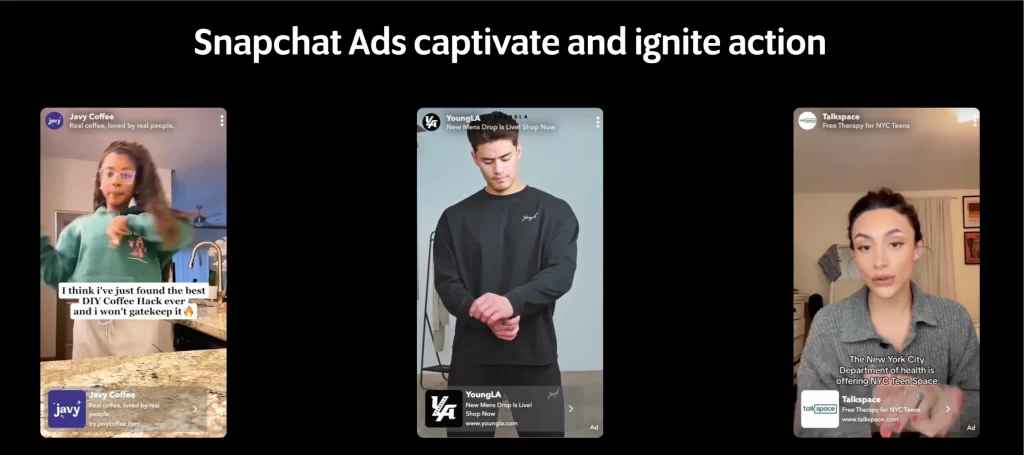
What Are Snapchat Ads (and How Do They Work)?
Snapchat ads are full-screen vertical videos (or images) that pop up between Snaps, Stories, and Spotlight content. Think TikTok meets Instagram Stories—with a playful twist.
So, how do Snapchat ads work exactly? Simple:
- You upload a creative (video, image, etc.)
- Choose a goal (clicks, installs, purchases, etc.)
- Set your budget and audience
- Snapchat places your ad where it’s likely to perform best
- Users can swipe up to visit your site, install an app, or watch more
The ads feel native. The targeting is smart. And the results? Surprisingly solid—if you know how to do it right.
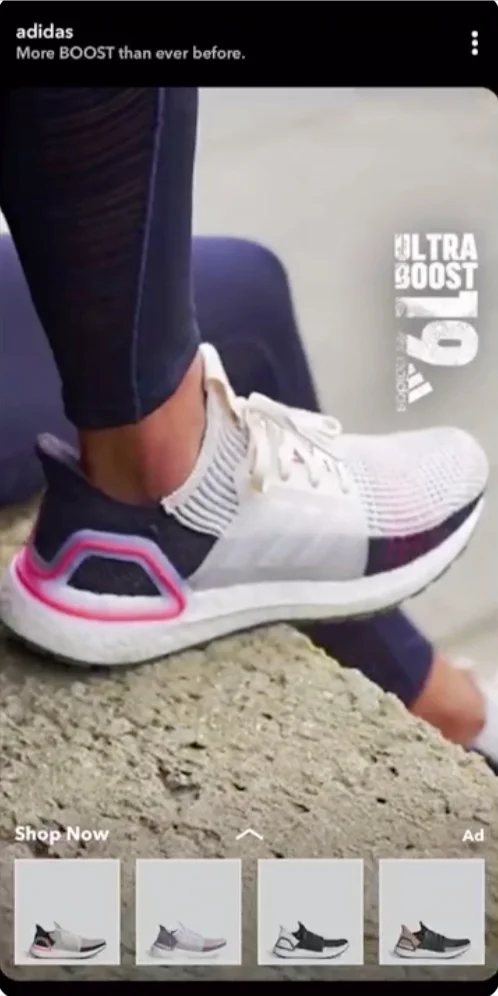
Snapchat Advertising Cost (What You Actually Need to Know)
Let’s talk numbers—because knowing how much it costs to advertise on Snapchat helps you plan smarter, not harder.
Minimum daily spend
You can technically get started with just $5 a day, which is great for testing the waters. But if you want to give the algorithm enough juice to learn and optimize, Snapchat recommends $20–$50/day. That sweet spot helps your campaign complete the “Exploration Phase” where it figures out what works.
TL;DR: $5/day works, but $20–$50/day gets you better results.
Average Snapchat advertising costs
Let’s break down the real-world performance numbers:
| Metric | Average Cost |
| CPM (Cost per 1,000 impressions) | ~$8.85 (varies from $3–$10) |
| Cost per Link Click (CPLC) | ~$1.93 |
| Cost per Swipe Up | As low as $0.04–$0.07 for well-targeted ads (yep, that low) |
Not bad for full-screen, immersive ads targeting Gen Z, right?
Premium Ad format costs
Thinking bigger? Snapchat has large-scale ad packages if you’re ready to go all in.
- Standard Snap Ads (Direct Buys): From $3,000/month
- Sponsored Lenses: Between $450,000–$700,000/day (yep, pricey but HUGE reach during major events)
- Discover Ads: Minimum $50,000/day
- Sponsored Geofilters: ~⅕ the price of Lenses.
Pro tip: Most small to mid-sized brands start with Snap Ads via self-serve Ads Manager and scale from there.
How Snapchat costs stack up against other platforms:
| Platform | Average CPM |
| Snapchat | ~$8.85 |
| ~$5.27 | |
| ~$4.31 |
Sure, Snapchat might look a bit pricier on the surface—but here’s the twist: Snapchat users engage more playfully, and swipe-up actions can cost just pennies.
That said, conversion rates (actual purchases or signups) tend to be lower than on Facebook or Google Ads—especially for sales-heavy campaigns. But if you’re after awareness, engagement, or app installs? Snapchat’s got serious potential for ROI.
Types of Snapchat Ads and When to Use Them
Snapchat’s got an ad format for every kind of business—whether you’re launching a new product, driving foot traffic, or building hype for a big sale. You can mix and match different ad types based on your goals, whether that’s racking up app installs, boosting ecommerce sales, or just getting your brand in front of the right eyes.
1. Single Image or Video Ads
Single Image or Video Ads are immersive, full-screen experiences designed to grab attention fast. Whether you’re aiming for website visits, app installs, or product awareness, these ads are built to drive action. Just include a swipe-up link to your landing page, and viewers can engage instantly.
These ads appear seamlessly between content from friends, creators, or publishers — right where attention is highest. You can upload a photo, video, GIF, or cinemagraph, with durations up to three minutes. But for maximum impact, keep it short and snappy — 3 to 5 seconds works best.
Best for:
- Brand awareness
- Driving website visits
- App installs
- Simple promotions or offers
When to use:
Ideal for advertisers new to Snapchat or those looking for a straightforward, cost-effective way to deliver a clear message or call-to-action.
Ad specs and requirements:
- File Types: .mp4, .mov, .jpg, .png
- Aspect Ratio: 9:16 (vertical)
- Resolution: 1080 x 1920 pixels
- Video Length: 3–180 seconds (3–5 seconds recommended)
- Image File Size: 32 MB max
- Video File Size: 1 GB max
- Audio: Optional, 2 channels only, PCM or AAC codec, 192 kbps minimum, 16/24 bit, 48 KHz sample rate
- Brand Name: Up to 25 characters (with spaces)
- Headline: Up to 34 characters (with spaces)
- Call-to-Action: Recommended; Snapchat provides preset CTA options
- Placement: Between Stories, Spotlight, Discover
2. Collection Ads
Snapchat Collection Ads let you showcase a main image or video with 3–4 tappable product tiles, all in a full-screen, swipeable format. These ads appear between Stories or in the Discover feed, making it easy for Snapchatters to browse and shop right from the ad.
Best for:
- Ecommerce brands
- Showcasing multiple products
- Promoting new collections or sales
When to use: Choose Collection Ads to drive product discovery and direct purchases, especially during product launches or seasonal promotions.
Ad specs and requirements:
- File Types: .jpg, .png, .mp4, .mov
- Aspect Ratio: 9:16
- Resolution: 1080 x 1920 pixels
- Video Length: 3–180 seconds
- File Size: 1 GB max
- Thumbnail Image: JPG/PNG, 160 x 160 px, must include a URL
- Brand Name: 25 characters max
- Headline: 34 characters max
- CTA: Recommended
- Placement: Full-screen with tappable product tiles
3. Story Ads
Snapchat Story Ads are full-screen, vertical ads that show up between or after content like User Stories, Creator Stories, and Discover. They’re built to feel native — so your brand gets noticed without interrupting the experience.
Best for:
- Deep engagement
- Storytelling campaigns
- Product launches or multi-step narratives
When to use: Choose Story Ads when you need to educate, entertain, or engage users with more content than a single ad allows—great for campaigns that benefit from sequential messaging or storytelling.
Ad specs and requirements:
- File Types: .mp4, .mov, .jpg, .png
- Aspect Ratio: 9:16
- Resolution: 1080 x 1920 pixels
- Content: 3–20 “snaps” (each can be image or video)
- Video Length: Up to 15 seconds per snap, total up to 180 seconds
- Image/Video File Size: 1 GB max per snap
- Brand Name: 25 characters max
- Headline: 34 characters max
- Title: 55 characters max
- Logo: PNG, 993 x 284 px
- Image: PNG, 360 x 600 px
- Placement: Discover section, branded tile opens to story sequence
4. AR Lenses (Augmented Reality Lenses)
Snapchat AR Lenses turn your brand into an interactive experience by using augmented reality to engage users in real time. With front- or world-facing camera effects, Snapchatters can try on products, play mini-games, or bring virtual objects into their environment — all from within the app.
Best for:
- Brand engagement and recall
- Viral campaigns
- Product try-ons (beauty, fashion, etc.)
- Event promotions
When to use: Opt for AR Lenses to create immersive, shareable experiences that encourage user interaction and brand play. They’re especially powerful for brands targeting Gen Z and Millennials, or for campaigns aiming for high attention and memorability.
Ad specs and requirements:
- Format: PNG with transparent background
- Resolution: 945 x 2048 px
- Audio: MP3 or WAV
- Types: Face AR Lens (front camera), World AR Lens (rear camera)
- 3D Assets: 3D Max or Maya files for 3D models; high-res layered PNG/PSD for 2D
- Logo: High-res PNG for branding
- Placement: Camera section, interactive user experience

5. Commercials
Snapchat Commercials are non-skippable, full-screen video ads that appear within premium content on Discover — like shows from top publishers and creators. These ads run up to 6 seconds and are designed to capture attention quickly with high-impact storytelling.
Best for:
- High-impact brand launches
- Time-sensitive promotions
- Driving mass awareness
When to use: Use Commercials for big moments when you want guaranteed viewability and attention, such as major product launches or limited-time offers.
Ad specs and requirements:
- File Types: .mp4, .mov (H.264 encoded)
- Aspect Ratio: 9:16
- Resolution: 1080 x 1920 pixels
- Standard Commercials: 3–6 seconds, unskippable
- Extended Commercials: 7–180 seconds (first 6 seconds unskippable)
- File Size: 1 GB max
- Attachments: Website, long-form video, or AR Lens
- Brand Name: 25 characters max
- Headline: 34 characters max
- Title: 55 characters max
- Logo: PNG, 993 x 284 px
- Image: PNG, 360 x 600 px
- Placement: Within curated content (Discover, Shows)
6. Filters
Snapchat Filter Ads let you add a branded overlay to Snapchatters’ photos and videos, making it easy for users to engage with your brand while they create and share content. These filters appear after a Snap is taken and can be applied to both selfies and world-facing shots.
Best for:
- Brand awareness
- Event or location-based promotions
- User-generated content campaigns
When to use: Deploy Filters to encourage organic sharing and participation, especially for local events, holidays, or brand activations.
Ad specs and requirements:
- Image Size: 1080 x 2340 px
- Format: PNG with transparent background
- File Size: 250 KB max
- Branding: Must include a visible brand logo or name
- Placement: Overlay option when users create Snaps
7. Dynamic Collection Ads
Snapchat Dynamic Collection Ads automatically showcase a personalized lineup of products to each Snapchatter — pulled directly from your product catalog in real time. Featuring a hero image or video with 3–4 tappable product tiles, these full-screen ads make it easy for users to browse and shop instantly. Overall, Dynamic Collection Ads update automatically based on inventory, pricing, and user behavior.
Best for:
- Retargeting
- Personalized product recommendations
- Large ecommerce catalogs
When to use: Ideal for ongoing, always-on campaigns that benefit from dynamic product recommendations and retargeting.
Ad specs and requirements:
- Aspect Ratio: 9:16
- Resolution: 1080 x 1920 px
- Video Length: 3–180 seconds
- Attachments: Website, app, or Lens
- File Types: .jpg, .png, .mp4, .mov
- Placement: Automated, personalized product tiles from catalog
Check our guide on how to use Snapchat for business.
How to Create Snapchat Ads (Step-by-Step)
To start running ads on Snapchat, you’ll first need a Snapchat account and access to Snapchat Ads Manager. From there, you’ll choose how to build your campaign — either with Instant Create for a quick setup or Advanced Create for full control.
In this guide, we’ll walk you through Advanced Create — perfect if you want to run multiple ads, build funnels, and fine-tune your targeting. Let’s dive in.
Step 1: Sign up for snapchat Ads Manager
Head to ads.snapchat.com and sign in with your Snapchat account. Create a Business Account. Easy.
Step 2: Pick your campaign objective
Snapchat gives you nine options—from Awareness to Catalog Sales. Choose based on what you want people to do.
Examples:
- Send traffic to your site? Choose Website Visits
- Promote your app? Go with App Installs
- Want conversions? Pick Website Conversions
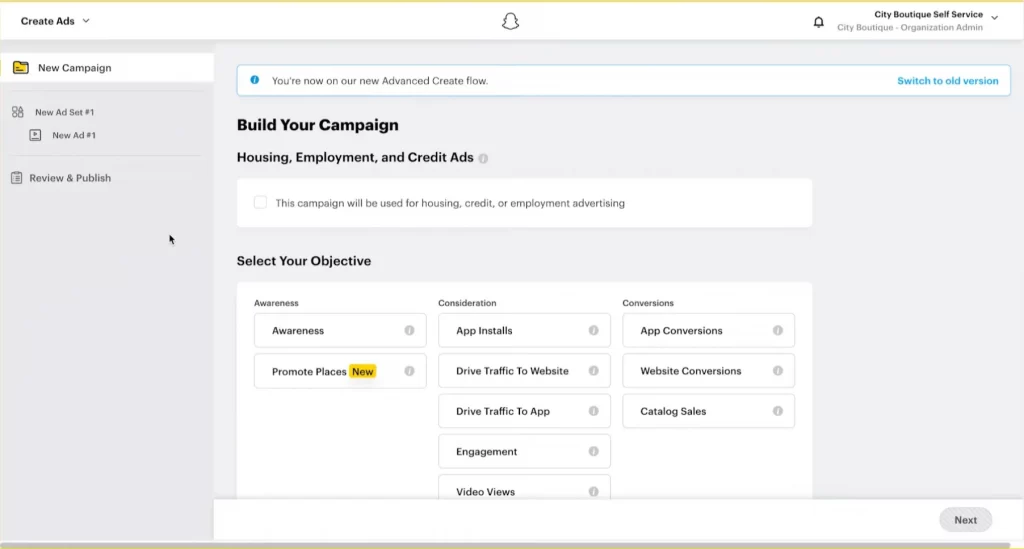
Step 3: Name It, budget It, schedule It
Give your campaign a name you’ll actually remember.
Set your daily or lifetime budget.
Choose your start and end dates.
Done.

Step 4: Build your ad set
This is where things get spicy:
- Choose the type of ads you want to run.
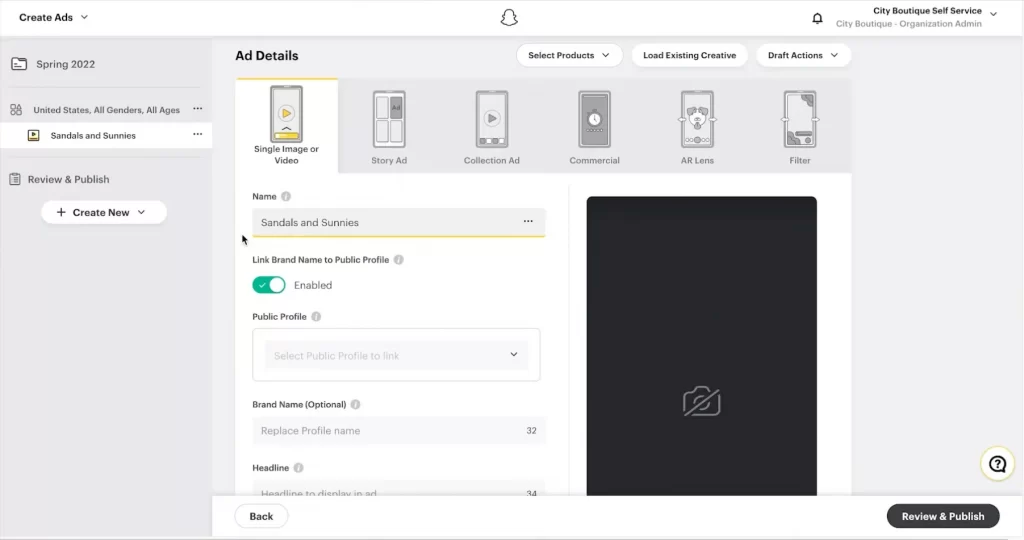
- Choose your audience (age, gender, interests, devices, location)
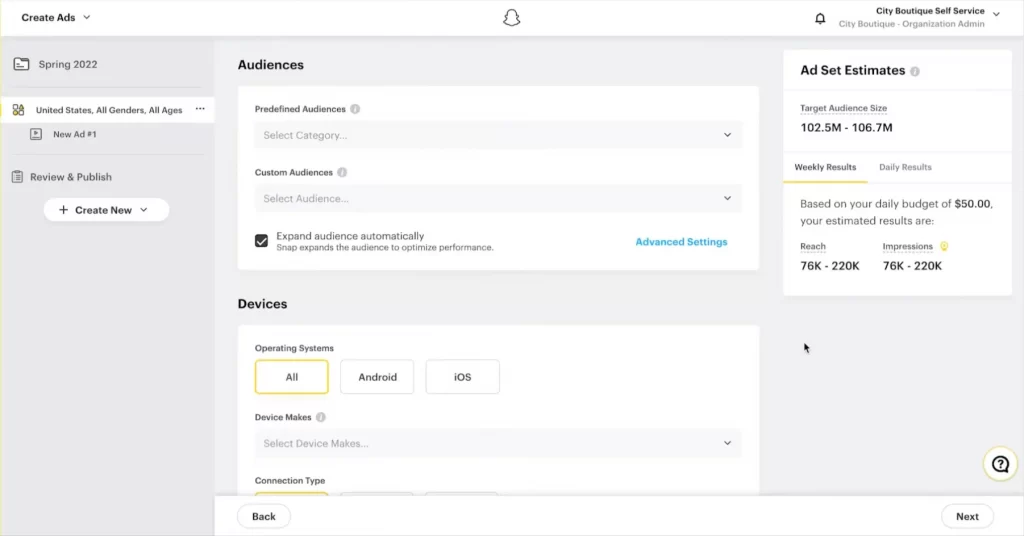
- Pick ad placements (Automatic is fine for beginners)
- Set your goal-based bidding strategy (ex: cost per swipe or impression)
Snapchat also lets you upload your own audiences or retarget based on Pixel activity.
Step 5: Design your ad
Upload your creative. Add a brand name, headline, CTA, and your swipe-up destination. Use Snapchat’s preview tool to see how it’ll look.
Not a designer? Use Snap Publisher—it’s free and built into Ads Manager.
Step 6: Review and publish
Double-check everything.
Add your payment info.
Click Publish Campaign.
You’re live!
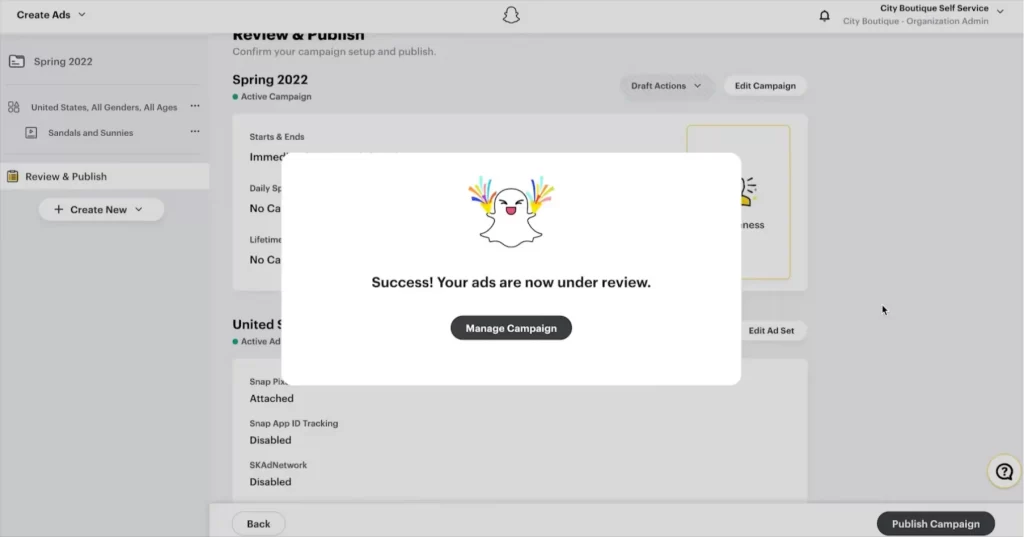
How to Advertise on Snapchat: Top Tips
Want your Snapchat ads to actually get swiped, tapped, and clicked? It’s not just about showing up—it’s about showing up right. From eye-catching creatives to smart targeting, there are a few key things that separate high-performing Snap ads from the ones users skip in a second.
Here are the top tips for advertising on Snapchat like a pro—whether you’re brand new to the platform or ready to scale your next campaign.
1. Get super clear on your objective
Don’t just run ads for the sake of it. Know what you’re trying to do:
- Want more eyeballs? Go for brand awareness.
- Promoting an app? Choose app installs.
- Want traffic or sales? Try website visits or conversions.
Snapchat’s audience is mostly Gen Z and Millennials—visual, fast-scrolling, and glued to their phones. Use that to your advantage.
Pro move: Take advantage of Snapchat’s killer targeting tools—age, gender, interest, behavior, even conditions like time of day or weather.
2. Pick the perfect ad format
Each format has a purpose—pick smart:
- Single Image/Video Ads = Great for awareness
- Story Ads = Great for telling, well, stories
- Collection Ads = Built for ecommerce—add to cart vibes
- AR Lenses and Filters = Ideal for viral, interactive experiences
- Commercials = Premium placements with serious visibility
Match your format to your goal, always.
3. Win the first 3 seconds
Snapchatters move fast. You’ve got maybe 2–3 seconds to hook them before the next swipe.
So:
- Lead with your strongest visual or value prop
- Show the product in action
- Get right to the point—don’t waste the intro
And please—don’t just slap your logo on a screen and call it a day. Be bold. Be fun. Be scroll-stopping.
4. Design for Mobile (and sound off)
Snapchat is 100% vertical and mobile-first.
Here’s how to get it right:
- Use 9:16 format and high-res assets
- Assume sound is off—add captions, overlays, and visual cues
- Go big on font size and leave out clutter—make it readable on a thumb-sized screen
Pretty doesn’t always perform. Make it punchy.
5. Hit them with a strong CTA early
If your call-to-action shows up at the very end, it might be too late.
Add a clear CTA like “Shop Now” or “Swipe Up” within the first few seconds. Make it pop with motion, urgency, or action-driven words like:
- Limited drop
- Only today
- Try it now
And if you can spark a little FOMO? Even better.
6. Add something interactive
Want to boost engagement? Use stuff that feels native to Snapchat:
- AR Lenses
- Custom Filters
- Stickers and overlays
These interactive formats blend in with how people already use the app—making your brand feel like a part of the experience, not a disruption.
7. Test, learn, repeat
Running ads without testing is like flying blind.
Start small. Use Snapchat’s built-in A/B testing to try different:
- Creatives
- Audiences
- Placements
- Objectives
Watch the numbers: impressions, swipe-ups, CPC, conversions, ROAS. Drop what flops. Scale what works.
8. Don’t sleep on your landing page
You got the swipe—now don’t blow it.
Make sure your landing page is:
- Fast (like under 3 seconds load time)
- Mobile-optimized
- Consistent with your ad (same look, tone, product, CTA)
Bonus tip: Add the Snap Pixel to track conversions and optimize retargeting later.
9. Keep it simple. Keep it visual.
You’ve got a 10-second (or less) window—make it count.
- Focus on one idea per ad
- Use bright visuals, bold fonts, and thumb-stopping design
- Keep copy short and snappy—save the essays for your blog
Snapchat is not the place for subtle. Be loud, be bold, be clear.
10. Retarget and build a funnel
Retargeting is where the magic happens.
Use Snap Audience Match to reach people who:
- Visited your site
- Watched your video
- Swiped on your ad
Then build a funnel:
- Awareness ad with a short video
- Retarget with a product benefit or testimonial
- Close with a discount, offer, or CTA-heavy push
That’s a full-funnel Snapchat strategy, right there.
How Do I Advertise on Snapchat?
Advertising on Snapchat is quick and beginner-friendly. Here’s how you can get started:
1. Create a business account. Head to ads.snapchat.com and sign up or convert your personal Snapchat account to a business profile.
2. Choose a campaign objective. Pick what you want to achieve—brand awareness, app installs, website traffic, or conversions.
3. Set up campaign details. Name your campaign, select your budget (starting at $5/day), and define start and end dates.
4. Define your target audience. Use Snapchat’s targeting tools to filter by demographics, interests, behaviors, location, or even custom audiences.
5. Select an ad format. Choose from formats like Single Image/Video, Story Ads, Collection Ads, AR Lenses, Commercials, and more.
6. Upload your creative. Use vertical 9:16 images or videos. Snapchat offers built-in templates and an editor to help.
7. Add a call-to-action. Choose CTAs like “Swipe Up” or “Shop Now.” Place them early in the ad for best performance.
8. Launch and optimize. Review your setup, go live, and monitor performance in Ads Manager to make data-driven adjustments.
How Much Does It Cost to Advertise on Snapchat?
Snapchat ads are affordable for most businesses, especially those testing the platform.
– Minimum daily budget. Starts at $5/day, but Snapchat recommends $20–$50/day to allow proper optimization.
– CPM (Cost per 1,000 Impressions). Typically ranges from $3 to $10, often lower than Facebook or Instagram.
– Cost per swipe-up. For well-targeted ads, expect $0.04 to $0.07 per swipe-up.
– Cost per conversion. Varies widely but often falls between $4 and $7 depending on your targeting and creative.
Overall, Snapchat is a budget-friendly option for reaching Gen Z and Millennial users—though performance depends on your product and ad quality.
Can Snapchat Be Used for Advertising?
Yes, absolutely. Snapchat is a legitimate advertising platform trusted by brands, creators, and marketers across industries.
It’s especially effective for:
– Targeting younger audiences (Gen Z and Millennials).
– Running interactive and visually-driven ads using formats like AR Lenses, Story Ads, and Collection Ads.
– Driving traffic, installs, and sales with robust targeting tools.
– Whether you’re a small business or a big brand, Snapchat gives you the tools to build awareness and drive real results.
Can You Advertise on Snapchat for Free?
Technically, no—you can’t run paid ads for free, but here are a few workarounds:
– Snapchat occasionally offers promo credits to new advertisers or during special promotions.
– You can promote content by posting to a public Snapchat profile or story, but this has limited visibility compared to paid ads.
– Creators can earn through affiliate links or brand deals on Snapchat, but that’s separate from its ad platform.
Final Thoughts: Is Snapchat Advertising Worth It?
If your audience skews young and your content is punchy, then yes—advertising on Snapchat can absolutely pay off.
It’s low-cost to start, fast to test, and packed with tools built for ecommerce. And now that you know how to advertise on Snapchat, from strategy to launch, you’re ready to go live with confidence.
So what are you waiting for?
- Try out a $10 test campaign this week.
- Promote your best-selling product.
- Track the results.
You might just unlock your brand’s next big growth channel.
To streamline your product advertising even further, consider using a feed management tool. LitCommerce’s Snapchat Feed Management helps automate and optimize your product listings, ensuring your campaigns stay accurate, up-to-date, and effective — all with less manual effort.



